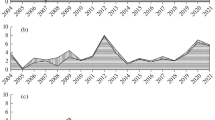Summary
A field work with two plots of grid, a snap trap being set on each station spaced 5 m apart, was executed in the summer of 1968 to evaluate prebaiting in census trapping by comparing the result in one plot, prebaited for three days, with that in the other not prebaited. Since the population was as high as some 230 per acre on the average in density and formed of the vole,Microtus montebelli, alone, sufficient samples were gathered irrespective of the plot size as small as 50×50 m.
Owning to the circumstances, multiple collisions inflicted so intense influence on sampling especially in the prebaited plot thatz-equation for census adjusted to the effect was well applicable to the data in either plot. In sampling, the fact that small voles are apt to be caught later than large voles was statistically evidenced in either sex, and yet any proof that males tend to be caught prior to females was not offered. It was ascertained in either plot that the daily catch was realized according to the same rule through the whole period of trapping in both external belt and internal square within the plot; hence it follows that no considerable immigration occurred.
One of the beneficial effects of prebaiting is sure to be that the probability of capture was markedly enhanced in the prebaited plot, and a second is supposed, though inconclusively, to be that a good sampling could be executed consistently through the census period giving rise to no inordinate catches perhaps due to heterogeneous sampling as was seen in earlier days in the not prebaited plot. The supposition has derived from the condition that most of the whole population is trappable, which is established by interrelation among population density, size of home range and trap spacing. It was suggested that the effect of prebaiting should be evaluated from the view-point of the interrelation, because the basic utility of prebaiting consists in that it may help to our utlimate purpose to estimate the whole population.
Similar content being viewed by others
References
Adamczuk, K. andL. Ryszkowski (1968) Estimation of the density of a rodent population using stained bait. Acta theriol.,13: 295–311.
Andrzejewski, R. (1967) Estimation of the abundance of small rodent populations for the use of biological productivity investigations. Sec. Prod. Terr. Ecos. (ed.K. Petrusewicz),I: 275–281.
Andrzejewski, R., K. Petrusewicz andJ. Waszkiewicz-Gliwicz (1967) The trappability ofClethrionomys glareolus and other ecological parameters obtained by the CMR capture method,Ekol. Polska, Ser. A,15: 709–725.
Calhoun, J.B. (1959) North Amer. Cens. Small Mamm., Release No. 10.
Davis, D.E. andJ.T. Emlen (1956) Differential trappability of rats according to size and age.J. Wildl. Mgt.,20: 326–327.
Gentry, J.B., F.B. Golley andM.H. Smith (1968) An evaluation of the proposed IBP cenus method for estimating small mammal populations,Acta theriol.,13: 313–327.
Janion, M., L. Ryszkowski andT. Wierzbowska (1968) Estimate of number of rodents with variable probability of capture.Acta theriol.,13: 285–294.
Kanamori, M. andR. Tanaka (1968) Studies on population ecology of the vole,Microtus montebelli, in mountain grasslands of Sugadaira and its adjacent areas. I. Results of research on five populations in 1966–1967.Bull. Sugadaira Biol. Lab., Tokyo Kyoiku Univ.,2: 17–39. (in Japanese).
Kikkawa, J. (1964) Movement, activity and distribution of the small rodentsClethrionomys glareolus andApodemus sylvaticus in woodland.J. Anim. Ecol.,33: 259–299.
Kott, E. (1965) Factors affecting estimates of meadow mouse populations. Ph. D. Thesis, Univ. Tronto.
Leslie, P.H. andD.H.S. Davis (1939) An attempt to determine the absolute number of rats on a given area.J. Anim. Ecol.,8: 94–113.
Morisita, M. (1962)I δ-index, a measure of dispersion of individuals.Res. Popul. Ecol.,4: 1–7.
Pelikan, J. (1967) The estimation of population density in small mammals.Sec. Prod. Terr. Ecos. (ed.K. Petrusewicz),I: 267–273.
Tanaka, R. (1962) A population ecology of rodent hosts of the scrub-typhus vector of Shikoku District with special reference to their true range in Japan.Jap. Journ. Zool.,13: 395–406.
Tanaka, R. (1963) Examination of the routine census equation by considering multiple collisions with a single-catch trap in small mammals.Jap. J. Ecol.,13: 16–21.
Tanaka, R. (1966) Simulated removal trapping considered in connection with actual census data in small mammals.Res. Popul. Ecol.,8: 14–19.
Tanaka, R. andM. Kanamori (1967) New regression formula to estimate the whole population for recapture-addicted small mammals.Res. Popul. Ecol.,9: 83–94.
Turček, F.J. (1967) Some methodical aspects of quantative studies of vertebrates. Part II: small mammals.Biológia, Bratislava,22: 438–445.
Zippin, C. (1956) An evaluation of the removal method of estimating animal populations.Biometrics,12: 163–189.
Author information
Authors and Affiliations
Additional information
Contribution from JIBP-PT No. 55, carried out by the grant from the expenditure of Education Department to the specific study on “Dynamics of Biosphere”
Rights and permissions
About this article
Cite this article
Tanaka, R., Kanamori, M. Inquiry into effects of prebaiting on removal census in a vole population. Res Popul Ecol 11, 1–13 (1969). https://doi.org/10.1007/BF02514506
Issue Date:
DOI: https://doi.org/10.1007/BF02514506



